 Today's Southwest Chief is a combination of two trains formerly operated by the Atchinson, Topeka, and Santa Fe Railroad; we'll call it Santa Fe or ATSF for short. The trains were known as Super Chief and El Capitan, and both made the same fast run from Chicago to Los Angeles on Santa Fe's main line, along with slower trains making the same route but with less fanfare, lower fares, and more stops. The route that Amtrak follows today is the same route Santa Fe used.
Today's Southwest Chief is a combination of two trains formerly operated by the Atchinson, Topeka, and Santa Fe Railroad; we'll call it Santa Fe or ATSF for short. The trains were known as Super Chief and El Capitan, and both made the same fast run from Chicago to Los Angeles on Santa Fe's main line, along with slower trains making the same route but with less fanfare, lower fares, and more stops. The route that Amtrak follows today is the same route Santa Fe used. On May 12, 1936, Santa Fe inaugurated an all new train, the Super Chief. This was the first diesel powered, all-Pullman train in the United States. Many railroads did not dieselize until after World War 2. The Santa Fe only had one trainset at first, and operated it once a week on a 40 hour schedule between origin and destination. About a year later, Santa Fe re-equipped the train with lightweight cars and new diesels and more trainsets, and inaugurated it once again. The inaugural run was completed in 36 hours and 49 minutes, a record which stands to this day. Before the war, Santa Fe ran this train nonstop between Kansas City, MO and Barstow, CA, with the exception of crew change points and servicing stops. During the war, the schedule was relaxed and passengers could get on or off at some of the bigger cities along the route, and after the war the schedule was relaxed again to allow passengers to get on and off at all the stops. The train was designed for celebrities traveling to Los Angeles, and earned the nickname "Train of the Stars."
On May 12, 1936, Santa Fe inaugurated an all new train, the Super Chief. This was the first diesel powered, all-Pullman train in the United States. Many railroads did not dieselize until after World War 2. The Santa Fe only had one trainset at first, and operated it once a week on a 40 hour schedule between origin and destination. About a year later, Santa Fe re-equipped the train with lightweight cars and new diesels and more trainsets, and inaugurated it once again. The inaugural run was completed in 36 hours and 49 minutes, a record which stands to this day. Before the war, Santa Fe ran this train nonstop between Kansas City, MO and Barstow, CA, with the exception of crew change points and servicing stops. During the war, the schedule was relaxed and passengers could get on or off at some of the bigger cities along the route, and after the war the schedule was relaxed again to allow passengers to get on and off at all the stops. The train was designed for celebrities traveling to Los Angeles, and earned the nickname "Train of the Stars."
In 1938, El Capitan started running once a week in each direction as an all-coach version of the Super Chief. El Capitan ran the same 40 hour schedule as the Chief, but made more stops because it was a coach train. Because of the extra speed and the Super Chief-style luxury, the fare was higher than any other train on the route, with the exception of the Super Chief itself. Also in 1938, the Super Chief began running twice a week. El Capitan followed suit in 1946, and the Super Chief was upgraded to daily operation the same year.
 |
| Photo from www.bcoolidge.com. |
Amtrak acquired the Super Chief and El Capitan equipment and ran both trains under their original names. In 1973, Amtrak dropped El Capitan, and in 1974 Santa Fe asked Amtrak to stop using the names Super Chief and Texas Chief, another former Santa Fe train that Amtrak took over, because Santa Fe felt that the Amtrak trains didn't live up to their original names, and the trains didn't deserve the names anymore. Super Chief and Texas Chief were renamed Southwest Limited and Lone Star. In 1984, Santa Fe allowed Amtrak to use the Chief name again, and the Southwest Limited became the Southwest Chief, and it runs under that name to this day.
 |
| Photo by Steven Welch. |

No comments:
Post a Comment